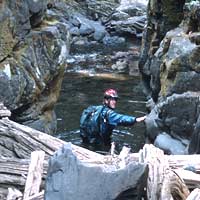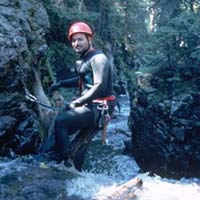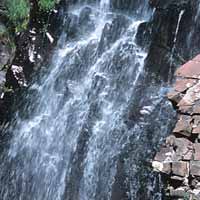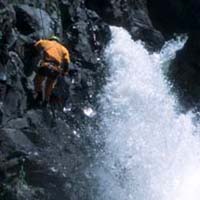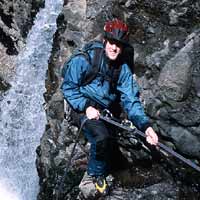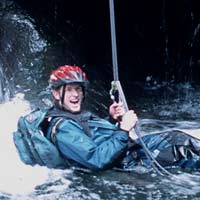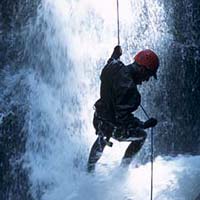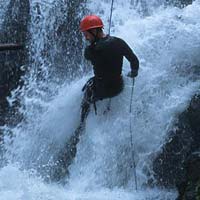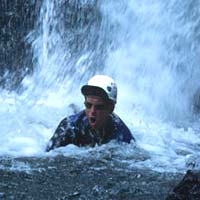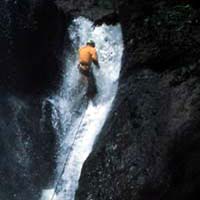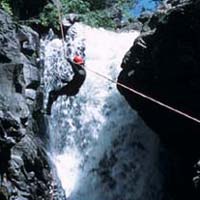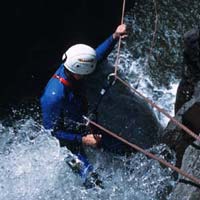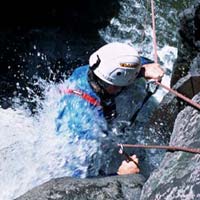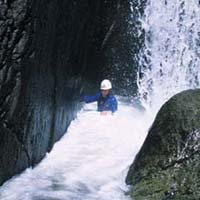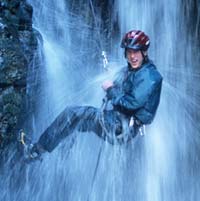|
INTRODUCTION
Canyoneering (the descent of technical canyons) is a relatively
new sport in the US. Utah and Northern Arizona a prime territories for the
practice of descending narrow sandstone slot canyons. These are very
colorful, technically demanding (especially in those with big potholes), but
rarely involve flowing water. In fact, when the water does flow it's
usually in the form of a flash flood, and you don't want to be there. Such
slots are known as dry canyons, even though there may be standing
water. Wet canyons have flowing water, and the most fun ones to do
have waterfalls that must be rapped through.
Colorado has hundreds of peaks in the 13,000 to 14,000 foot
range. Each peak will have many canyons on its slopes. Stands to
reason that Colorado should be a haven for spectacular water canyons. Not
all canyons are great, you need a very steep drop (for example 500 feet per
mile, or more) to get sharp walls and big waterfalls. And you don't just
want one falls in a canyon. The more the better.
Recently several enthusiasts have been perusing topos and going
out to explore for big-water canyons with multiple drops. One of the
classics, discovered just a few years ago by Charly Oliver and Mark Day of
Boulder, CO, is the west side of Wolf Creek, near Pagosa Springs. There
are two sections, divided by the highway bridge. Upper WC has 10
waterfalls and Lower WC has 6. Either as a single day, or two half-days,
of adventure, it's hard to beat.
Special methods are required to safely get down this canyon,
especially if the flow is strong. I learned some very helpful methods in American
Canyoneering Association classes, and by going out with people who knew what
they were doing. You need to be prepared with special equipment and
skills, but boy-oh-boy this is a fun sport.
DOING THE DESCENT
Even a given water canyon can take
on a very different face, from mellow to ferocious, depending on the
runoff. Wolf Creek is fed by snowmelt early in the season, and is never
exactly "warm". A thick (5mm or more) and full wetsuit, or even
better a drysuit (especially if you like to play in the water), is
necessary. A good rope management system is required because you don't
want rope getting tangled underwater, or around anyone trying to swim.
Safety gear (PFD - life jacket, throw-bag, ascenders, valdotan...) is also essential, particularly
when the water is big. It goes without saying that good info and skills
w.r.t. anchors
and obstacles is crucial. Anchors vary in water canyons. Logs,
boulders, trees, and horns can often be found, but are not necessarily reliably
available, as water moves things around and changes these canyons. Bolts
might be necessary at some drops, and one should go prepared for many alternatives (lots of
webbing, hooks, wrench, ....).
Choice of route is often critical. Sometimes you have to
re-direct and avoid the water altogether, or at least choose the safest path
down. This is particularly true as water strength grows downstream as a
result of feeds from side-streams, springs, and seeps.
GUIDED RAPPELS
One very neat method for getting past nasty plunge pools is to
send your best swimmer through, or to belay your best climber down and around, a
big hydraulic. He or she tows the rope and sets up one half the rope as a
guideline for the rest of the group. Those lucky folks then get to avoid the big
hydraulic.
WILD WATER CANYONS = WAY COOL!
|

